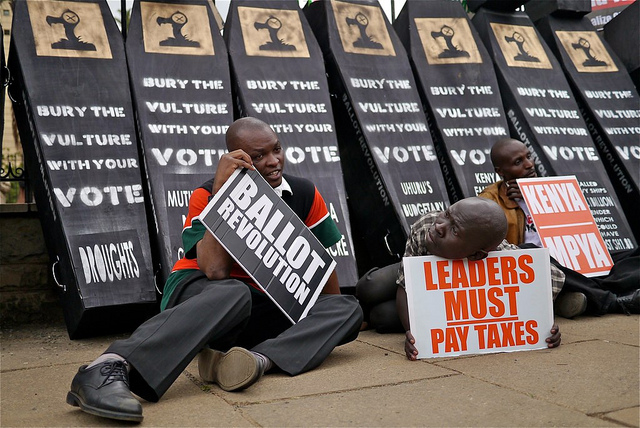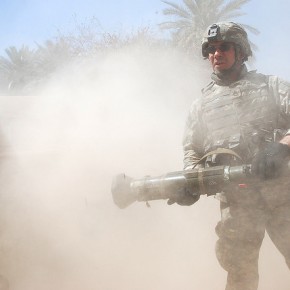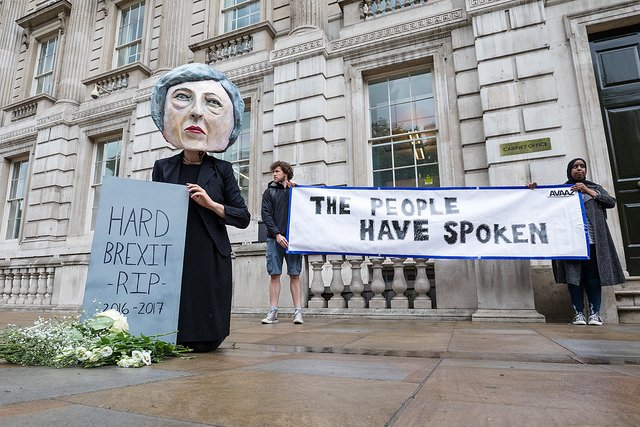Kenya’s elections went better than expected. True, accusations of vote rigging have led the losers to contest the result. More alarming, however, both the newly-elected president and his running mate are under indictment by the International Criminal Court for crimes against humanity. On the other hand, given that the December 2007 elections resulted in over 1,000 deaths and 300,000 refugees, the ICC cases are infinitely preferable.
The violence in Kenya was an immediate matter of concern for both the United States and the EU. Kenya is, in the parlance of the policy wonks, an anchor state in East Africa. With a government that had been relatively stable both throughout and since the Cold War, and with Nairobi functioning as the banking and financial center of the region, Kenya is looked upon in Washington and the European capitals as a backstop against potential instability in the Horn of Africa and in the eastern part of the sub-Saharan zone. The outbreak of serious violence conducted on an inter-ethnic basis (predominantly between the Kikuyu and Kalenjin) seemed to suggest a failure of the state.
With the most recent elections, this concern seems to have been allayed. The winning partnership of Uhuru Kenyatta and William Ruto have important connections to Kenyan history (Kenyatta is the son of Kenya’s first president, Jomo Kenyatta.) Perhaps more importantly, Kenyatta and Ruto represent a kind of inter-communal solidarity that Western politicians find comforting. Kenyatta is a Kikuyu, Ruto a Kalenjin. To Western eyes, this looks like an important step forward for Kenya, and there is some truth to this, although the reasons behind it are rather different than those fixated on the ethnic conflicts seem to think.
There is a tendency for observers in the north to assume that inter-communal conflict in so-called “less developed countries” is the result of the ancient hatreds, of grudges stretching back to time immemorial. Thus, when violence breaks out between ethnic Serbs and Croats in the Balkans, or between Sunnis and Shi’ites in the Middle East, the ready explanation is that this is an expression of hatreds that predate these people’s entry into history, defined more or less as their integration into international capitalist civilization. This can be seen with particular intensity in the case of Africa, a region which in Western eyes is the definitive case of the power of ahistorical otherness to resist the imposition of the civilizing mission.
Thus, when violence between the Kikuyu and Kalenjin ethnic groups flared in the wake of the 2007, there was a strong temptation in the western media to see it as an expression of Africa’s “dark” history reasserting itself. In a sense this was true, except that the darkness stemmed not from some pre-historic tribal conflict, but from the settlement of Kenya’s colonial past. The transition from British colonial rule to independence in 1963, and the political and economic arrangements that informed it, have shaped Kenyan politics ever since. If the political settlement following the most recent electoral cycle had been more pacific than in earlier iterations, it is no less the case the politics of Kenya are, in an important sense, the outgrowth of a post-colonial political economy.

Many look at the Mau Mau rebellion of the early 1950s as a defining moment in Kenyan history. Yet, it was really events before and after this conflict that had the most profound effects on subsequent history. The underlying cause of the uprising was the expropriation of land, predominantly from the Kikuyu, Meru, and Embu peoples of the highlands, by European colonizers. While the British sought to characterize the rebellion as a resort to atavistic tribalism, it had much more to do with land hunger among the Kikuyu, then as now the most numerous ethnic group in the country.
Although the Mau Mau had been effectively crushed by 1956, it politicized the Kikuyu in ways that would have important consequences in later years. When Jomo Kenyatta, a Kikuyu, became Kenya’s president in 1964, many in Kikuyuland hoped that he would redress the situation of those with little or no land, a high percentage of whom had taken part in the rebellion. In this they were disappointed. Kenyatta had never had any connection to the Mau Mau, and made it clear that he regarded them as thugs. More importantly, he opposed redistribution of land, and his government made it clear that access to it would be dependent on the ability to pay.
This set the tone for post-independence Kenyan politics. Kenyatta, who has been viewed with such alarm by the colonial authorities that they imprisoned him (wrongly) as a leader of the Mau Mau from 1953 to 1959, quickly showed himself to be an apt caretaker of the relationships between British and Kenyan elites formed in the last years of the colonial period. Under his leadership, and that of his party, the Kenya African National Union (KANU,) the political institutions of the Kenyan state were reconfigured. Although the constitution that was promulgated in 1963 contained strongly federalist elements, this ran counter to the policy and goals of Kenyatta and his party.
With these elements eliminated, and with the nation’s only other national political party, the Kenya African Democratic Union (KADU) merged with the KANU in 1964, Kenya became a top-heavy, one party state for the better part of three decades. Post-independence politics in Kenya have been about maintaining control over this highly centralized institutional apparatus. This has sometimes been accomplished via the promotion of ethnic coalitions, at other times through the instigation of inter-communal violence, and not infrequently through repression and assassinations.
Much of this period saw Kenya ruled by Daniel arap Moi, whose brutality and spectacular corruption was excused by his allies in Washington and Europe because his regime was stable although increasingly economically stagnant. Prosperity under Kenyatta had tended to favor the Kikuyu. This had as much to do the with his need to preserve the economic power that came with control of the former “white highlands,” the most fertile farmland in the country.
Moi redressed this balance in favor of his own Kalenjin ethnic group, but mostly be stacking the bureaucracy with Kalenjin clients. When forced to return to democratic governance in 1991, by the threat by international donors to withhold $250 million in aid, Moi made skillful use of interethnic politics by playing smaller ethnic groups off against larger ones. The basis of his ability to do so was the competition for increasingly scarce resources, rather than any ostensibly “pre-historic” animosities.
The political situation between Moi’s departure from office in 2002 and Uhuru Kenyatta’s election earlier this year has been marked by continuities with this history. Although there have been periodic attempts to replace the constitution with one that devolves more power away from the executive and the bureaucracy (culminating in the approval of a new constitution in 2010,) power, both political and economic, remains in the hands of a narrow elite with only nominal ties to ethnic politics. Kenyatta, a Kikuyu, was the Kalenjin Moi’s handpicked successor in 2001. The fact that it has taken him a decade to attain the position that his mentor marked out for him reflects the complexity of the political competition amongst Kenya’s elites, rather than the problems of ethnic conflict.
Kenyan politics in the post-independence era reflects an important historical dimension. Rather than conflicts reaching out from a pre-civilizational past, Kenyan politics have been shaped by an elite-led settlement between colonizer and colonized, and by the competition for political spoils undertaken by Kenyans who benefitted from that arrangement. If the threat of prosecution by the ICC has resulted in a change of strategy on the part of Kenyan politicians, it has done nothing to shift the loci of power in the country, nor in any immediate sense, to promote the devolution of that power from the wealthy strata within which it now rests.
Some world leaders have professed uneasiness at the prospect of dealing with the Kenyatta-Ruto administration. This feeling is likely to recede, especially since the case against Ruto has now collapsed (after a key witness recanted his testimony.) The position of Kenyatta and Ruto,as the gatekeepers of foreign investment in the Kenyan economy, suggests that any such discomfort is something that can be worked through.
Photographs courtesy of What Kt Did. Published under a Creative Commons license.





